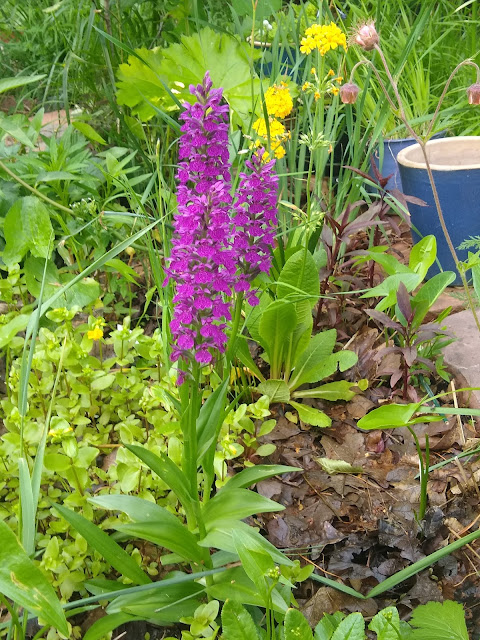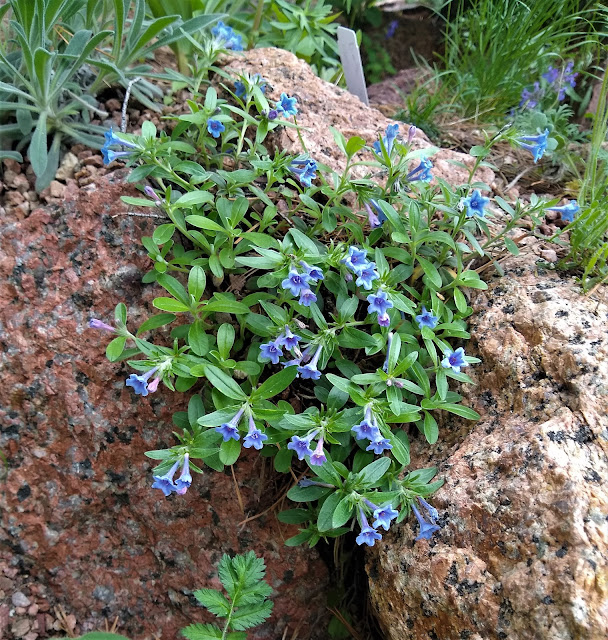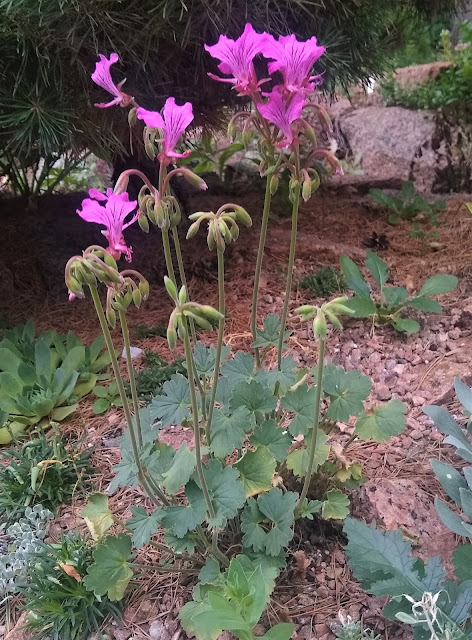Aquilegia flabellata 'Nana' Not quite in alphabetical order, but I need an eye-catching opener--and who doesn't dote on this East Asian gem of a columbine? I finally have it in a trough where it seems to be happy.
 |
Acantholimon sp. July 4
|
I believe I've done a yearly retrospective of some of my favorite plants that bloomed in my garden just about every end of the year going back nearly fifteen years. I start with Acantholimon--one of my VERY favorite genera (yes, I know I have a lot of them). Sadly, these do not like my Quince St. garden: except for a few exceptions. This is one of them!
 |
Allium zebdanense sp. May 10
|
Onions, like Violets and Oxalis--are among the very worst weeds one can let into a rock garden. Yet among the vast Allium clan there are dozens of species that are indispensible garden plants. This is one of the strangest of the lot--utterly charming in bloom and very easy to grow--it disappears completely a few weeks after it blooms until the next year. It's NEVER sold by nurseries: you can only get it from fellow rock gardeners--in my case from Gary and Tom Whittenbaugh--who have an extraordinary rock garden in Oelwein, Iowa who have gifted me many treasures!
 |
Ancistrocactus tobuschii February 6
|
A gift from Pat and Joel Hayward--from their land in West Texas. This is regarded as an extremely rare plant--only it was was quite abundant on their property. I grow it indoors in the winter--although it may possess some hardiness: I have a sheltered corner in my dryland garden where marginal cacti thrive--but I shan't try this out till I have numbers of them! It does bloom prodigally for weeks in late winter--but no seed yet.
 |
| Androsace taurica May 18 |
A cardinal rule of rock gardening: you can NEVER have enough androsaces! This is one of the easiest to grow as well as being a choice one!
 |
Anthyllis coccinea June 1
|
I have seen acres of yellow Anthyllis on Mount Olympus, and I had the classic vari-colored A. vulneraria spreading aggressively at Denver Botanic Gardens (it's been reined in by Mike K.)--but this smaller one seems manageable as well as being beautiful. It's a keeper!
 |
| Aquilegia coerulea June 5 |
I always try and keep a few of our state flower around--not just because I'm patriotic. It is a gorgeous thing--and it was found just south of Denver by Edwin James (who named it) in June of 1820--little more than 200 years ago this year--giving this an extra bit of meaning!
 |
Aruncus 'Zweiweltkind' June10
|
I see typical Goatsbeard here and there around Denver: I need it. I even have a good place for it now (not in this more intimate corner) but this considerably dwarfer form developed in Germany years ago is right in scale for the garden here,,,
 |
Caltha palustris 'Flore Pleno' April 2
|
The picture may have been taken in April, but this looks pretty stunning from late February all the way to May--one of the longest blooming perennials! Alas, one needs a bog to grow it!
 |
Aleuriopteris argentea June 10
|
One of my earliest horticultural passions was for ferns: sixty years later, I'm still collecting and studying them--this being one of the most charming of them all. As it matures, the "silver cloak fern" lives up to its name--the undersurface of the fronds is powdery white (the "Aleuri" in its generic name is the Greek word for flour: αλεύρι. Knowing Greek does make Scientific names easier to understand!). I found this (or something very similar) at Tiger Leaping Gorge by the upper Yangtse in Yunnan: it apparently is fairly widespread and common across China, Taiwan and possibly even Alaska (according to Lemmon's 1882 booklet on the ferns and fern allies of the Pacific Coast). Thanks to Casa Flora, this is widely grown and sold in the U.S.A.--even by Monrovia. All the husky large specimens I've planted didn't overwinter--but this sproreling from my neighbor Kirby Demott HAS made it through last winter! Thank you Kirby!
 |
Cheilanthes wootonii Sept. 1
|
This occurs in Southeastern Colorado, although I've yet to find it there (although I've found many unique and wonderful dryland ferns in Baca County). I gotta go back! These were grown from spore by Mary Hegedus--and are coming into their own. A really lovely drylander
 |
Corydalis kuznetsovii April 4
|
I keep forgetting to self the flowers to get some seed set (Jim Archibald taught me how to do that). Or I suppose I can divide the clump one day. It would be nice to have this spread about like some of its cousins...
 |
Crocus vernus v. albiflorus
|
I shall never forget finding masses of this blooming by the snow on Maloja pass in June of 1994. I have grown this for almost as long--first at DBG and an offset or two made it to Quince St. where it gets a little bigger every year (the triumphs of the gardener)...
 |
Dactylorhiza majalis June 16
|
My sad little trophy: only one crown survived when I divided my big clump into 20 pieces..oh well, at least one of them made it!
 |
Daphne x susannae 'Anton Fahndrich' on the right and D. x schytleri on the left. May 10
|
Blooming later this year--these two have blended into one another (the photo is deceiving--x susannae 'Anton Fahndrich' is really a much more purple than the pinker x schytleri. These are probably at their peak performance--but I have younger ones elsewhere for when these inevitably decline.
 |
Daphne x susannae 'Anton Fahndrich'
|
Whenever this monster comes into its own in late April, I declare a sort of personal holiday, and stand and gaze and sniff and enjoy it on and off for a few hours (performing other tasks, I aver!). Few plants have given me more delight for more years (or provided more cuttings to more nurserymen!). I imagine there must be hundreds of gardens in the Denver area with propagules from this...I wish I could visit them all!
 |
Delphium treleasei June 15
|
Okay, okay. I confess--I'm going through a Delphinium phase...don't tease me--at least I'm not going through a dandelion phase or plantain phase! I'm hoping against hope this one comes back---a rather rare species from Missouri....
 |
Delphinium tricorne June 1
|
I've been yearning to grow this since I saw it in vast sweeps at Missouri Botanic Gardens' satellite Arboretum one late April nearly 20 years ago. Remarkably similar superficially to our local prairie plant (
D. nuttallii) especially in color. I'd like to have the icy blue form I've seen now and again over the years..let's hope this settles down and starts seeding! (it did produce seed).
 |
Dianthus arenarius? June 10
|
Over the decades I've grown plants that looked like this as D. arenarius, as D. lumnitzeri and other names as well: this individual has been long lived and sets lots of seed.
 |
Dianthus thymphristus June 4
|
Not a choice bun. Not a huge flower. But charming enough I want more. Of course, it helps that I've been on Mount Tymphristos! (Where I first found Acantholimon wild in Europe!)
 |
Dictamnus angustifolius (white flowered form)
|
It really is different from the common white flowered form from Europe--I've seen this one in Central Asia (Kazakhstan) but only in purple.
 |
| Dictamnus albus(white flowered form) |
Now I need the Caucasian species!
 |
Erigeron ursinus
|
I seem to have a lot of fleabanes: this is one of the best. I collected the seed of this at the type locality twenty five years ago perhaps, and have grown it ever since.
 |
Erysimum pallasii
|
This poor plant has had a chequered nomenclatural history. I knew it as E. amoenum for ages. Then it was lumped into E. nivale as just a color phase. Then both were lumped into E. capitatum as merely alpine races. Now taxonomists decide it's a disjunct race of the arctic purple wallflower. Which one is right?
 |
Fibigia macrocarpa
|
One of those quiet plants that keep chuggin' along...
 |
Fritillaria kurdica in the snow
|
Obiously kin to F. michaelovskyi...so far so good!
 |
Fritillaria nigra
|
Aptly named, this leapt to the top of my "favorites" list when it bloomed this year: hope it persists!
 |
Heuchera bracteata
|
Our commonest local alumroot of the Front Range: a greenish chartreuse in color. But it does perform!
 |
Hypericum olympicum
|
I blush to show this: I dug it up not long after I took the picture--way too much real estate and it was squelching some other choice plants. I have this elsewhere in the garden where it won't be such a hog. But a rather pretty hog, I admit! (I was able to divide it into about 50 pieces--hope they come through the winter in the nursery!)
 |
Ikonninikovia kaufmanii
|
I collected the seed of this in Kazakhstan: not terribly showy--but I love all Plumbaginaceae. And this is one no one else has. I don't think they do anyway!
 |
Iris x histrioides cv.
|
One of the dozens of reticulate irises I've grown in recent years: I'll have to double check on the cultivar name--check back in a week or so!
 |
Iris ruthenica (tall)
|
Much taller and distinct in other ways, but I believe it's still an Iris ruthenica.
 |
| Kniphofia porphyrantha |
|
This purportedly traces (via Far Reaches Farm) to my collection in 1994 on Mount-au-Sources. Trouble is the plant I collected it from was solid yellow...
 |
Lithodora oleifolia
|
We can't grow L. diffusa like they do in the Pacific Northwest or Britain. But we CAN grow this gem!
 |
Mertensia virginica
|
There was a local garden belonging to my favorite chair of DBG's board that was chockablock full of this. I regretted never asking for some divisions before he moved. But I've managed to get hold it and hope it self sows for me as well!
 |
Erythrantha (Mimulus) cupreus
|
Purchased as annuals, perhaps these will perennialize? Every color but yellow or the coppery orange (the only colors I've seen these in in Argentina and Chile)...
 |
Opuntia polyacantha 'Raspberry Ice'
|
My best cactus collection (from eastern Colorado). The frosty buds and purplish flowers are the reason for the name.
Orostachys fimbriata
Every autumn I admire the strange pink-orange candles of bloom on this. I bring it in before hard frost and get a lot of seed--I must be sure to sow some this year! I believe this accession is from Suzhou where it supposedly grow in roofs there--although I didn't see it anywhere I looked when I visited the city 20 years ago.
 |
Orostachys minuta
|
This one blooms months earlier. It's ridiculously tiny--and wonderful!
 |
Papaver orientale 'Beauty of Livermere'
|
There are certain people who are daft about poppies. I happen to be one of them: my garden is a veritable anthology of poppies from spring to late fall. But the week or two when THIS one blooms has to be the culmination. Each year I try to capture the outrageous crimson and black blossoms...
 |
Papaver orientale 'Beauty of Livermere'
|
I think I came close this year to doing it: that red color really frustrates the camera. But it doesn't frustrate me.
 |
Pediocactus despainii
|
I think I've featured this tiny cactus many times before on this yearly run down. I searched for it at its type locality once. One day I must go there when it's in bloom and worship.
 |
Pelargonium endlicherianum
|
I've finally found a few spots where this outrageous plant seems to grow well. Few plants provide a longer season of fantastic form and color--and in the height of summer doldrums!
 |
Podophyllum emodi
|
I did a whole blog about these: gifts to me from Far Reaches Farm, arguably the greatest nursery in the world. I think I have fifteen or more dotted around my garden, and DBG ended up with three or four times that. They look different in every light and every few minutes it seems--more of a ballerina than a plant in some ways--and it has powerful medical application (breast cancer treatment).
 |
Podophyllum emodi
|
 |
Primula auricula
|
One can never have too many primulas--and this is one of the best. This helped to melt the heart of Jack Durrance, one of the early directors of DBG (and curmudgeon board member) who hated the Rock Alpine Garden until I toured him around: he saw this and almost wept (he'd gone to school in Switzerland and remembered this and its German name). Obviously, I'll always have to grow it--Jack became a good friend and huge champion of my work.
 |
Primula kisoana
|
Finally have this Japanese woodlander ramping about...
 |
Primula woronowii
|
Very different from all the forms I saw in Georgia (whence this came)--I'll take it!
 |
Sanguinaria canadensis 'Multiplex'
|
I once had tons of this at DBG and it petered out largely. Same at my house, only now its seeming to be spreading again! Hooray!
 |
Synthyris stellata
|
I once had many of its cousin (S. missurica) which I didn't properly propagate and distribute: never again! I've been able to get them both again, and will be sure to shepherd them to lots of people over time! (BTW, I'm ignoring the lumpers who crammed this into overfull "Veronica")
 |
Toxicoscordon venenosum
|
Finally giving in on this name, although I much prefer Zigadenus! this is finally beginning to seed about!
 |
Trillium nivale
|
One of my favorite of all spring bulbs. I hope I might have a few more blooming in a few years!
 |
Tulipa orphanidea
|
One of the last tulips to bloom--love that burnt orange color. It ramps a big, but oh well...the more the merrier!
 |
Verbascum atroviolaceum (phoeniceum)
|
I've seen this in both the Caucasus of Georgia and the Altai mountains of Central Asia--and now it's popping up all over my garden, which pleases me no end!
 |
| Veronica gentianoides 'Little Blues' |
I dedicated a whole blog post to this veronica a few months ago: veronicas are one of my favorite genera...OK, I admit I have a few dozen favorites! But they're right up there--just behind Gentiana, Salvia, Iris, Penstemon, Pediocactus, Primula, Fritillaria, Galanthus...and a few others!
If you've made it this far, you may have the fortitude to compare these to the last few years:
2020: https://prairiebreak.blogspot.com/2020/12/
2019: https://prairiebreak.blogspot.com/2019/12/year-in-retrospect.html





































































